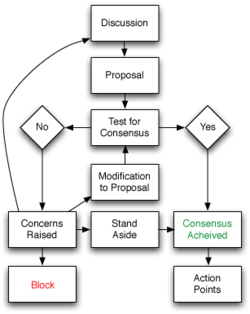
This is the third in a series of posts inspired by my visit to a meeting of Save Our Water Rights (SOWR) this past week. While I was there, I tried to help a tiny bit with their organization process, and these posts are a way for me to try to help both SOWR and other groups who want to petition for redress of grievances (
here's a list of the 5 First Amendment Freedoms, including the
right to petition).
Our system of government depends not just on our having these rights, but on our
actually using them.But just yelling at one another isn't what the Framers had in mind. For example, about a year ago the country was caught up in the debate over health care reform. The summer congressional recess had been marked by angry town hall meetings, so extreme that some people worried that violence might spill into the streets.
I got together a group of citizens to work on organizing a series of intentionally civil, nonpartisan town hall meetings for Ellensburg and Kittitas County. There was no hope of getting a public official to come to the meetings, and it was even pretty hard to find speakers. I finally found a brave retired doctor to speak at the first one, had a panel discussion for the second one, and invited Jimmie Applegate, a leader in the Republican Party, to speak at the last one. I handed out a card (front and back shown above, click to enlarge) to help people frame their statements as usefully as possible. The meetings all went well, and they were good practice for everyone. Here's the
Daily Record's story about the first meeting.
What follows is some of what I have learned from the health care town halls and other experiences.
1. When you ask someone to listen to you, especially in an official setting like a public hearing, you're asking them to give you something very precious: their time. If you want to have the best chance of helping them see things your way, you'd better respect their time.
2. You respect everyone's time when you deliver the best statement you can. Just as we have rules for driving, games, spelling, and even war, we have rules for arguing. Some of these are covered by the guidelines shown in the inset above.
3. You have the best chance of having your argument be heard if you follow the rules. There are extensive lists of fallacious arguments to avoid;
here's my favorite. One important form of argument to avoid is
needling, which means saying things simply to make your opponent angry. It weakens your argument and wastes time, and worse yet, it can give you the illusion that you're winning, which is another reason to avoid it. Knowing how to withstand the effects of needling is also a good idea.
4. Not following the rules can be fun, and even tactically useful -- unfortunately this approach is used too often in politics by all sides -- but if you're serious about trying to fix real problems, your best bet is to stick to the rules. With all the problems we have to solve, we really don't have time to mess around.
5. Never, ever, suggest, mention, or threaten violence, not even as a joke.
6. Be critical of your own arguments and thinking. Play devil's advocate to your own ideas, and test them on other people who can try to poke holes in them. As you find weaknesses in your arguments, fix them. Be open to the possibility that you're wrong.
7. Use facts, and expect others to use facts. Don't cherry-pick information.
8. Try to stick to what's relevant, especially at public hearings: the officials you're talking to have specific things they are looking for. For examples, see my posts on
conditional use considerations.








